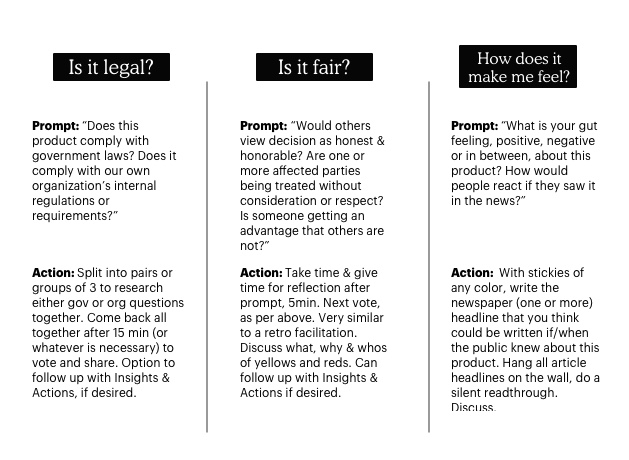Ethics Frameworks [WIP]
Frameworks for balanced teams considering the outcomes of the products they create
Exercises:
Product TimelineBeta
Yin-YangBeta
Do, Think, Feel, Say, EcosystemBeta
Issue-Contingent Model
(Coming Soon)
The Blanchard-Peale
Whether we are the original creator or joined the product team at a later point in time, we as technologists bear a collective responsibility to knowing and being connected in this way. This is a straightforward three-step ethical examination which can help a team or an individual evaluate a product or feature decision. The Blanchard-Peale approach can be easily utilized to enhance the performance of your product, your business model and increase individual understanding of the ethics behind any particular endeavor. The exercise is inspired by the 1988 book, The Power of Ethical Management, by Norman V Peale and Ken Blanchard.
When to do this exercise:
Either before or after product has been built and released to users to help a team ideate and understand how other members on their team view the collective strategy efforts. Group alignment or consensus is not the goal for this exercise (and many others in The Ethics Toolkit). The priority is to develop individual understanding and provoke thought. Simply delving into and understanding personal, group/team, organizational, and government views is the objective. As a result of doing this exercise early in product development, a team can raise their concerns with product leadership before an app is made public or an individual who is potentially uneasy with a strategic direction can opt-out.

How:
- Draw three, large vertical sections on a whiteboard.
- Label them at the top from left to right: “Is it legal?”, “Is it fair?”, “How does it make me feel?”
- Beginning on the left side with legal, give this prompt to the group: “Does this product comply with government laws? Does it comply with our own organization’s internal regulations, requirements, or brand/mission?”
- Split into pairs or groups of 3 to research either government or organizational questions together and gain new understanding of laws that you may not currently have. Everyone comes together after 15 minutes of investigation.
- Next gather 3 piles of stickies: one green, one yellow, and one red. Each person gets one stack of each color. Use the stickies to vote. Red=Stop, Yellow=Concern or Caution, Green=Go.
- Read the initial questions for the section one more time, and allow each person to come to the board to vote with a single red, yellow, or green stickie.
- Repeat the same steps with the second and third columns. For the fair column, give the prompt, “Would others view decision as honest & honorable? Are one or more affected parties being treated without consideration or respect? Is someone getting an advantage that others are not?”. For the feel column give the prompt, “What is your gut feeling, positive, negative or in between, about this product or feature? How would people react if they saw it in a newspaper headline?”
- After the vote for each section, take just a few minutes for individual read-through and reflection. After all three sections have been completed and voted on, discuss the outcomes as a group. This will be very similar to a retro facilitation. Point to and read aloud any red and yellow votes and ask people within the team to share why they or others might have voted that way.
- Optional follow up of an Insights & Actions exercise, if desired.
Materials List:
- Green, Yellow, and Red Post-It notes. One small stack of each color, per person.
- Sharpie Pens, thick. Best for viewing handwriting from far away.
- Large white board and dry erase markers or large white paper and pens that will be easily legible from far away.
- A timer or cell phone for time boxing.